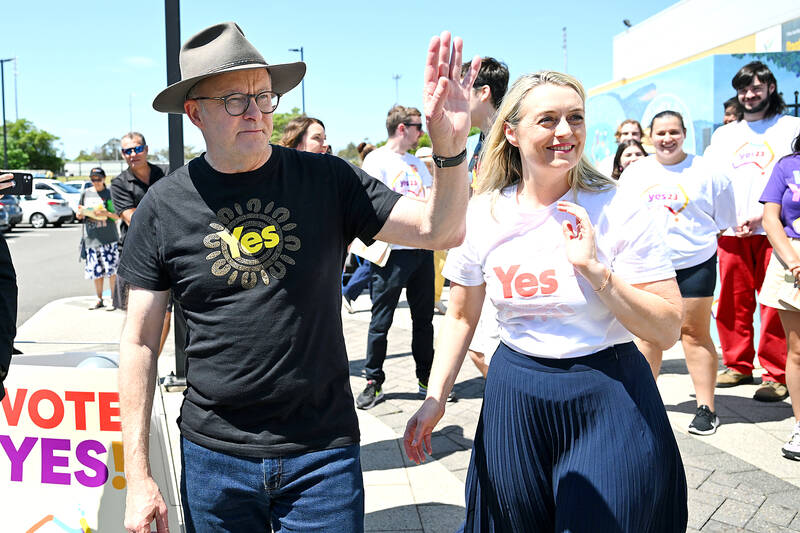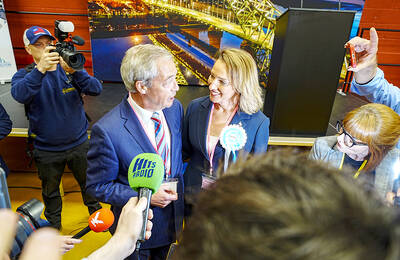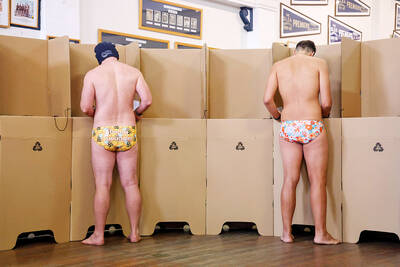Australians rejected giving indigenous people constitutional recognition and greater rights in a landmark referendum yesterday, Australian Deputy Prime Minister Richard Marles said.
“Australians have not voted for a change to the constitution,” Marles said, as partial results pointed to a resounding defeat for the reform. “We very much respect this result.”
Almost 18 million Australians registered to vote in they landmark referendum on constitutional changes to acknowledge Aboriginal and Torres Strait Islanders for the first time.

Photo: EPA-EFE
The proposed reforms would also have created an Indigenous Voice to Parliament — to weigh laws that affect those communities and help address profound social and economic inequality.
More than 230 years since the first British penal ships anchored in Sydney, the center-left government proposed the reforms as a step toward racial reconciliation — a reckoning with Australia’s bloody colonial past.
Instead, it has sparked a rancorous and racially tinged debate that exposed a gulf between First Nations people and the white majority.
With almost one-fifth of the 8,253 polling places reporting, the “no” campaign was leading “yes” votes by 58 to 42 percent.
Australia’s First Nations peoples have lived on the continent for more than 60,000 years.
Today, Aboriginal and Torres Strait Islander people make up less than 4 percent of the population, but are much more likely to be sick, imprisoned or to die young than their generally wealthier white compatriots.
Polls have consistently shown that voters would reject the proposals and that indigenous issues rank low on any list of public priorities for most Australians, far behind concerns such as the rising cost of living.
In the days before the vote, media attention has focused as much on events in the Middle East as the political debate at home.
“Yes” campaigner Karen Wyatt said she was “trying to stay positive” in the face of a seemingly inevitable defeat.
Hard questions are already being asked about what a “no” vote would say about Australia and Australians.
A rejection of the Voice would be “a shameful day for Australia,” 59-year-old Wyatt said in Sydney.
“I think it does say something for the path of this country, to say ‘no’ to something that was a simple request and a generous proposition,” she said. “I hope if it is a ‘no,’ we can recover from it and move forward.”
The opposition campaign has been successful in channeling fears about the role and effectiveness of the Voice assembly, encouraging people to vote “no” if they are uncertain.
Dee Duchesne, 60, a volunteer for the “no” campaign, said she was “fighting to keep an extra layer of bureaucracy out of our constitution.”
She said she had been called racist while handing out leaflets near a Sydney polling station during early voting.
“I’m not,” she said.
Australian Prime Minister Anthony Albanese has spent a year and much precious political capital advocating for the “yes” campaign.
On the day of the referendum he made an emotional plea to voters, asking them to right a historical wrong.
“This week of all weeks, with so much hatred displayed in the world, this is an opportunity for Australians to show kindness,” he said. “This is about respect for indigenous Australians. It’s about how we see ourselves as a nation, but it’s also about the way that the world sees us.”

Kehinde Sanni spends his days smoothing out dents and repainting scratched bumpers in a modest autobody shop in Lagos. He has never left Nigeria, yet he speaks glowingly of Burkina Faso military leader Ibrahim Traore. “Nigeria needs someone like Ibrahim Traore of Burkina Faso. He is doing well for his country,” Sanni said. His admiration is shaped by a steady stream of viral videos, memes and social media posts — many misleading or outright false — portraying Traore as a fearless reformer who defied Western powers and reclaimed his country’s dignity. The Burkinabe strongman swept into power following a coup in September 2022

‘FRAGMENTING’: British politics have for a long time been dominated by the Labor Party and the Tories, but polls suggest that Reform now poses a significant challenge Hard-right upstarts Reform UK snatched a parliamentary seat from British Prime Minister Keir Starmer’s Labor Party yesterday in local elections that dealt a blow to the UK’s two establishment parties. Reform, led by anti-immigrant firebrand Nigel Farage, won the by-election in Runcorn and Helsby in northwest England by just six votes, as it picked up gains in other localities, including one mayoralty. The group’s strong showing continues momentum it built up at last year’s general election and appears to confirm a trend that the UK is entering an era of multi-party politics. “For the movement, for the party it’s a very, very big

ENTERTAINMENT: Rio officials have a history of organizing massive concerts on Copacabana Beach, with Madonna’s show drawing about 1.6 million fans last year Lady Gaga on Saturday night gave a free concert in front of 2 million fans who poured onto Copacabana Beach in Rio de Janeiro for the biggest show of her career. “Tonight, we’re making history... Thank you for making history with me,” Lady Gaga told a screaming crowd. The Mother Monster, as she is known, started the show at about 10:10pm local time with her 2011 song Bloody Mary. Cries of joy rose from the tightly packed fans who sang and danced shoulder-to-shoulder on the vast stretch of sand. Concert organizers said 2.1 million people attended the show. Lady Gaga

SUPPORT: The Australian prime minister promised to back Kyiv against Russia’s invasion, saying: ‘That’s my government’s position. It was yesterday. It still is’ Left-leaning Australian Prime Minister Anthony Albanese yesterday basked in his landslide election win, promising a “disciplined, orderly” government to confront cost-of-living pain and tariff turmoil. People clapped as the 62-year-old and his fiancee, Jodie Haydon, who visited his old inner Sydney haunt, Cafe Italia, surrounded by a crowd of jostling photographers and journalists. Albanese’s Labor Party is on course to win at least 83 seats in the 150-member parliament, partial results showed. Opposition leader Peter Dutton’s conservative Liberal-National coalition had just 38 seats, and other parties 12. Another 17 seats were still in doubt. “We will be a disciplined, orderly